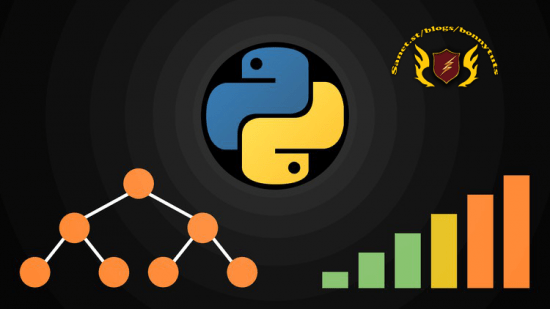
用Python实现排序算法,并通过动画理解它们是如何工作的。排序是计算机科学中的一个基本概念,对于许多应用程序都是必不可少的。本课程将通过详细的动画教你最重要的排序算法是如何工作的,以及如何用Python实现它们。本课程结束时,你将对五种流行的排序算法有一个坚实的理解:冒泡排序、选择排序、插入排序、快速排序和合并排序。我们将从第一部分开始,首先介绍排序、大O符号和主定理的大致概述。对于每种排序算法,都有一个单独的部分,在这里我们将深入研究至少两个视频。第一个视频始终作为底层算法的介绍,涵盖其核心概念、相应的Python代码和实际例子。一个额外的示例视频可用于快速排序,因为它对于初学者来说是一个很难理解的算法。通过提供非常详细的示例,相应的视频旨在简化学习过程,并帮助学习者更好地理解快速排序及其实现的联系。在第二个视频中,我们对算法的特性进行了全面的分析。这主要包括检查它的稳定性,它是否执行就地排序,以及它在各种情况下的时间复杂度,例如最好、一般和最坏的情况。Sorting Algorithms in Python (Animation-Based)
本课程面向任何希望更好地理解排序算法和一点Python编程的人。今天就加入这个课程,迈出成为分类专家的第一步!
由Carmine Caiaro创作
MP4 |视频:h264,1280×720 |音频:AAC,44.1 KHz,2声道
类型:电子学习|语言:英语|时长:19节课(3小时40分钟)|大小:754 MB 含课程文件
你会学到什么
五种重要的基于比较的排序算法:冒泡排序、选择排序、插入排序、快速排序和合并排序。
将代码中的每一行与其在算法中的用途联系起来。
如何用Python实现覆盖排序算法?
使用大O符号比较排序算法的效率。
要求
基本编程(数据类型、变量、循环、函数等。)
时间复杂性分析的基本数学(求和、函数等)。)
要自己运行代码并进行实验,您需要在设备上安装Python 3。
这门课程是给谁的
计算机科学学生
大学毕业生
软件工程师
Implement sorting Algorithms in Python and understand how they work through animations.
What you’ll learn
Five important comparison based sorting algorithms: Bubble Sort, Selection Sort, Insertion Sort, Quick Sort and Merge Sort.
Relate each line in the code with its purpose in the algorithm.
How to implement the covered sorting algorithms in Python.
Compare the efficiency of sorting algorithms using the Big O Notation.
Requirements
Basic programming (Data types, variables, loops, functions, etc.)
Basic math for the time complexity analysis (Summations, functions, etc.)
To run the code and experiment by yourself, you will need to have Python 3 installed on your device.
Description
Sorting is a fundamental concept in computer science and is essential for many applications. This course will teach you through detailed animations how the most important sorting algorithms work and how to implement them in Python. By the end of this course, you will have a solid understanding of the five popular sorting algorithms: Bubble Sort, Selection Sort, Insertion Sort, Quick Sort and Merge Sort. We will start in the first section with an introduction to sorting, the Big O notation, and a rough overview over the master theorem. For each sorting algorithm, there is a separate section, where we’ll delve into at least two videos. The first video serves always as an introduction to the underlying algorithm, covering its core concept, the corresponding Python code, and practical examples. An additional example video is available for Quick Sort, as it can be a challenging algorithm for beginners to understand. By providing a very detailed example, the corresponding video aims to simplify the learning process and help learners gain a better understanding of the connection of Quick Sort and its implementation.In the second video, we conduct a comprehensive analysis of the algorithm’s properties. This includes mainly examining its stability, whether it performs in-place sorting, as well as its time complexity under various cases such as best, average, and worst-case scenarios.This course is for anyone who wants to gain a better understanding of sorting algorithms and a bit of Python programming. Join this course today and take the first step in becoming an expert in sorting!
Who this course is for
Computer Science Students
College Graduates
Software engineers
1、登录后,打赏30元成为VIP会员,全站资源免费获取!
2、资源默认为百度网盘链接,请用浏览器打开输入提取码不要有多余空格,如无法获取 请联系微信 yunqiaonet 补发。
3、分卷压缩包资源 需全部下载后解压第一个压缩包即可,下载过程不要强制中断 建议用winrar解压或360解压缩软件解压!
4、云桥CG资源站所发布资源仅供用户自学自用,用户需以学习为目的,按需下载,严禁批量采集搬运共享资源等行为,望知悉!!!
5、云桥CG资源站,感谢您的赞赏与支持!平台所收取打赏费用仅作为平台服务器租赁及人员维护资金 费用不为素材本身费用,望理解知悉!













